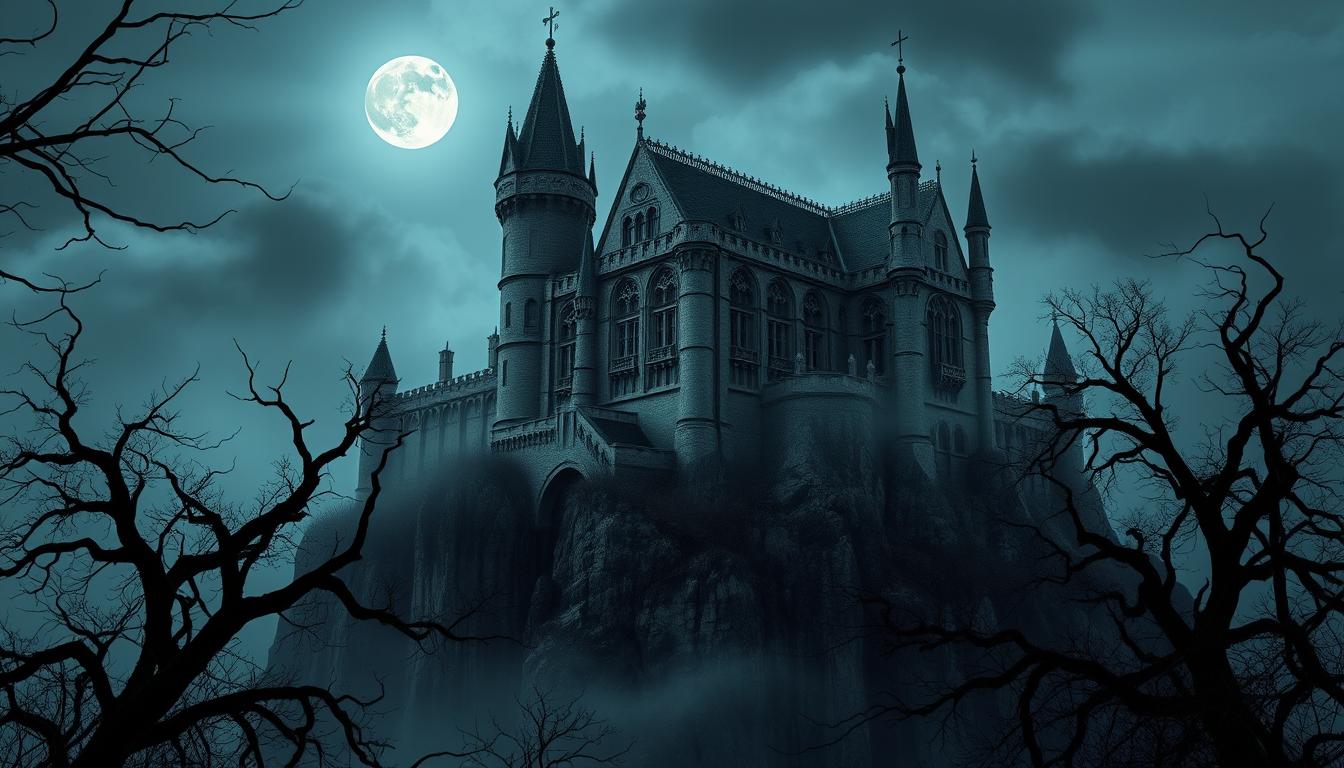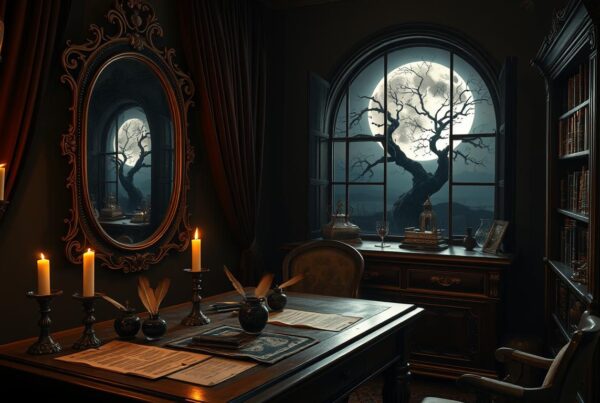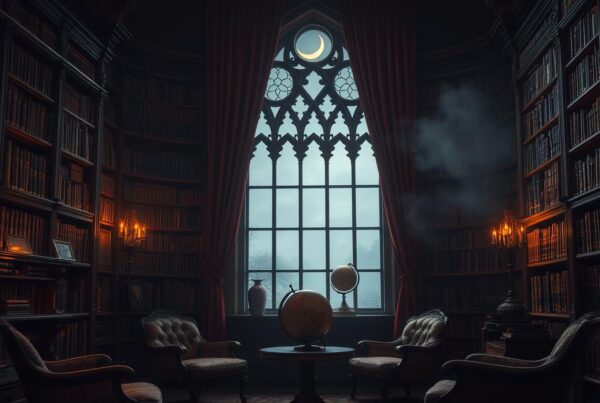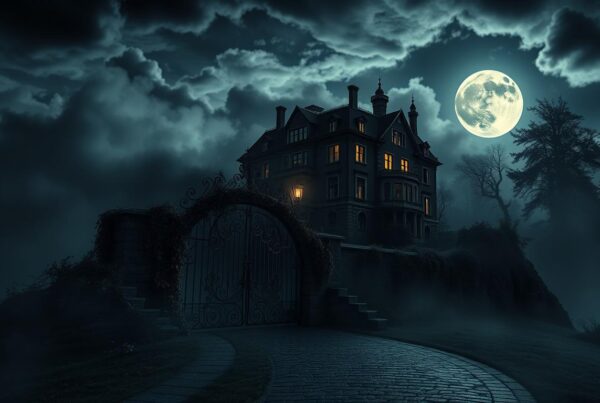Gothic romance has long held readers spellbound. It uses mysterious castles and brooding settings. These structures are like silent characters, shaping the fate of lovers.
Castles in romantic literature have crumbling towers and secret passages. Their stone walls whisper tales of forbidden love. Hidden chambers hold long-buried secrets.
The allure of these dark fortresses is in their reflection of inner turmoil. As characters face treacherous emotions, the castle’s corridors mirror the heart’s path.
Readers are drawn into a world of danger and mystery. The castle setting makes every glance and promise intense. It creates an atmosphere full of anticipation and desire.
The Origins of Gothic Romance and Dark Castle Settings
Gothic literature started in the late 18th century. It mixed horror and romance. Dark castles became key, adding to the thrill of love and fear.
Early Gothic Literature’s Impact
“The Castle of Otranto” by Horace Walpole was the first Gothic novel. It brought supernatural events into a medieval castle. This sparked a new trend in literature.
Rise of the Castle Motif
The castle motif became a big part of Gothic stories. Castles stood for power, secrets, and isolation. They added to the fear and wonder in stories.
Influential Gothic Authors
Many Gothic authors made the genre popular. Ann Radcliffe, with “The Mysteries of Udolpho,” was a master of suspense. Mary Shelley’s “Frankenstein” used a castle lab for a groundbreaking story. These authors made the castle a key part of Gothic literature.
Architectural Elements That Define Gothic Castles
Gothic architecture in medieval castles is full of mystery and romance. These structures have amazed people for centuries. Towering turrets reach high, offering great views and acting as lookout points.
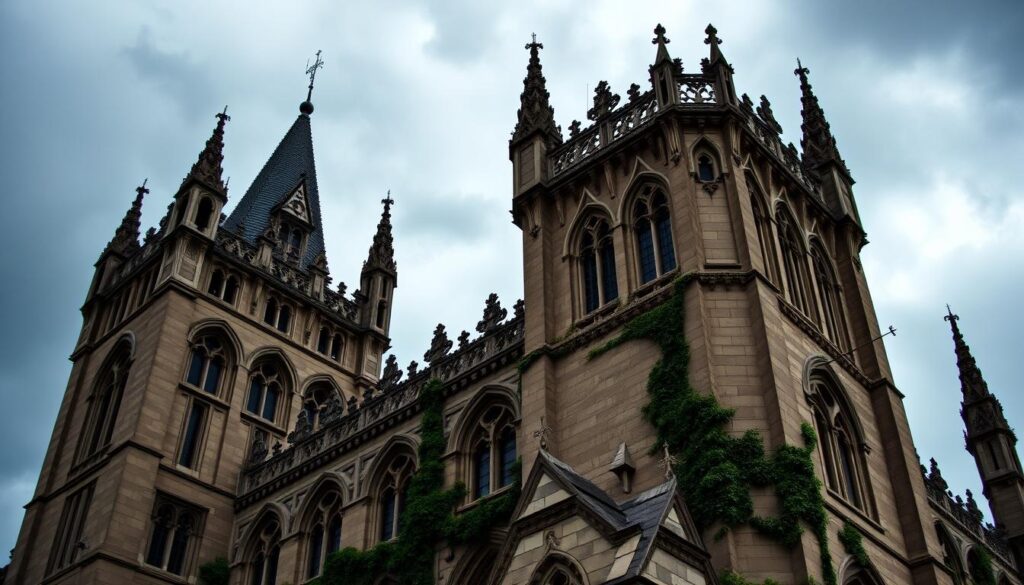
Pointed arches are a key feature, found in windows and doorways. They make the buildings look taller and more impressive. The arches also support the structure and make the eye move upwards, creating awe.
Gargoyles, the stone figures, are both useful and decorative. They help direct rainwater away from the castle walls. Their eerie faces and forms add to the castle’s magical feel.
Intricate stone carvings decorate walls and columns. They show the skill of medieval craftsmen. These carvings often show religious scenes, mythical creatures, or symbols. The way light and shadow play on them makes the castle walls seem alive.
Flying buttresses support the castle’s high ceilings and large windows. This engineering allows for big, bright spaces inside. The mix of these elements makes Gothic castles perfect for stories of love, mystery, and the supernatural.
Symbolism of Dark Castles in Gothic Literature
Dark castles are key in Gothic literature, more than just places. They symbolize mystery and romance. Castle metaphors carry complex ideas and feelings.
Isolation and Mystery
Gothic castles often stand alone, away from the world. This mirrors characters’ inner struggles and creates unease. Hidden passages and locked rooms add mystery, inviting readers to explore with the characters.
Power Dynamics and Social Hierarchy
Castles in Gothic tales show power structures. Their walls and halls reflect social divides. Characters move through these spaces, testing or supporting social norms.
The contrast between rich rooms and dark dungeons shows class and moral differences.
The Supernatural and the Unknown
Gothic literature loves the supernatural, and castles are perfect for it. Ghosts, strange sounds, and eerie feelings mix reality and fantasy. These events often symbolize characters’ inner struggles or past issues.
Through these symbols, Gothic castles become part of the story. They shape the tale and deepen emotions. They offer an experience that draws readers through the ages.
Iconic Dark Castles in Classic Gothic Novels
Classic Gothic novels have given us some of the most famous Gothic castles in literature. These dark structures are more than just settings. They become characters, shaping stories and leaving deep impressions on readers.
Bram Stoker’s “Dracula” introduces us to Castle Dracula, high in the Carpathian Mountains. This fortress, with crumbling walls and dark corridors, shows the menace and mystery of its vampire. It’s one of the most recognizable landmarks in Gothic fiction.
Charlotte Brontë’s “Jane Eyre” features Thornfield Hall, a grand manor with secrets. Its hidden attic symbolizes concealed truths and repressed desires. Thornfield Hall shows the complexity of Gothic settings in classic novels.
Emily Brontë’s “Wuthering Heights” has the eponymous farmhouse, which feels like a castle in its isolation. While not a traditional castle, Wuthering Heights shows how Gothic authors use spaces to create mood and tension.
These famous Gothic castles from classic Gothic novels still captivate readers today. They’ve inspired many adaptations and homages. This has made them lasting literary landmarks in the Gothic tradition.
The Psychological Impact of Castle Settings on Characters
Gothic psychology shapes characters in dark castles. These places are more than just backgrounds. They deeply affect the minds of those inside.
The castle’s influence drives character growth and emotional struggles in Gothic love stories.
Claustrophobia and Paranoia
Gothic castles’ high walls and narrow paths can make characters feel trapped. This feeling can cause paranoia. They might start to suspect every little thing.
This fear and doubt add to their emotional struggles and move the story along.
Transformation and Self-Discovery
Castles push characters to face their deepest fears and desires. Being alone, they learn a lot about themselves. This can reveal hidden strengths or dark secrets.
This journey changes them, shaping their path in the story.
Blurring Reality and Imagination
The spooky feel of Gothic castles mixes reality with dreams. Characters may find it hard to tell what’s real and what’s not. This makes their mental state complex.
This mix of truth and fantasy adds to the emotional turmoil in Gothic stories. It keeps readers guessing and excited for what’s next.
The Allure of Dark Castles in Gothic Love Stories
Dark castles are perfect for Gothic love stories. They create a setting full of intense romance and forbidden love. Inside, secret passageways and hidden chambers wait to be found.
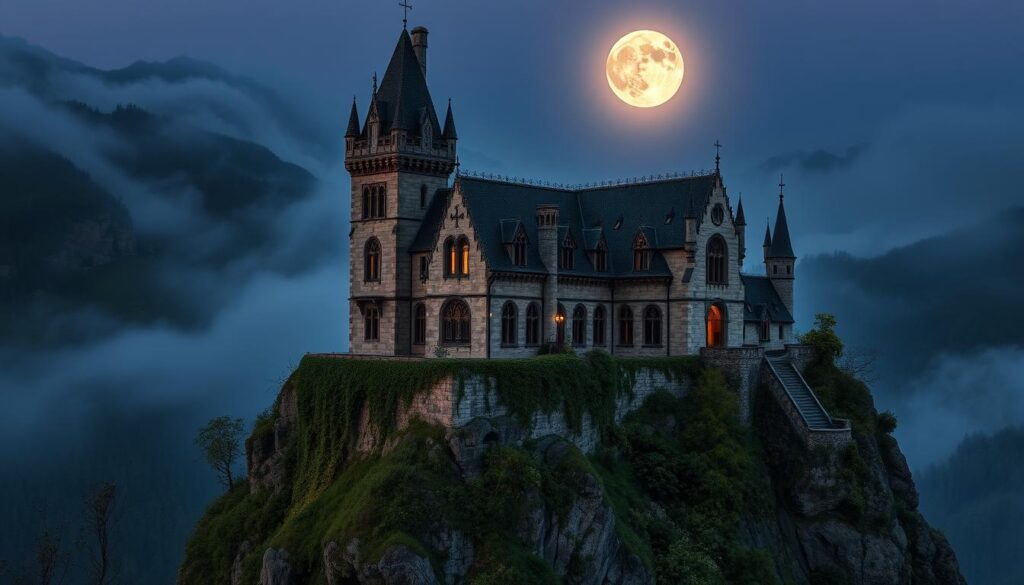
The castle’s halls and dark corridors are like characters. They see lovers’ secret glances and quiet talks in dark spots. This setting makes every moment feel more important and risky.
Gothic romance often has a brooding hero with a secret past. The castle shows his complex side, making him even more appealing. The heroine, pulled into this world, faces her feelings and the castle’s secrets.
Forbidden love grows in these isolated places. Characters from different worlds meet, breaking social rules. The castle’s isolation brings them close, while dangers offer chances for rescue and protection. This mix creates strong bonds between unlikely pairs.
The charm of dark castles in Gothic love stories is their ability to make romance more intense. They offer a rich setting where love and danger mix, creating unforgettable stories.
The Role of Weather and Atmosphere in Castle-Based Gothic Romance
Stormy weather makes Gothic romances exciting. Dark clouds cover ancient towers, creating a spooky mood. Lightning lights up dark hallways, and thunder shakes the walls.
Weather shows what characters feel inside. This is called pathetic fallacy. It makes the castle seem alive. Winds howl, showing a heroine’s fears. Rain shows a hero’s sadness.
Fog is key in Gothic castle stories. It hides the world, mixing reality with dreams. Characters get lost in foggy gardens or see ghosts in shadows. This mystery makes every moment thrilling.
Light and shadow create a spooky castle mood. Candles flicker, making shadows dance. Moonlight through stained glass windows casts eerie patterns. These changes keep everyone on edge, perfect for a Gothic love story.
Modern Adaptations of Gothic Castles in Contemporary Fiction
The dark castle theme still draws readers into contemporary Gothic stories. Writers have updated these mysterious places for today’s tastes. They keep their spooky charm, making the genre fresh and appealing to new fans.
Neo-Gothic Literature
Neo-Gothic stories mix old Gothic vibes with today’s themes. Authors like Sarah Waters and Carlos Ruiz Zafón have done this well. They add dark castles and manor houses to their tales, making them deeper and more interesting.
Gothic Elements in Paranormal Romance
Paranormal romance loves Gothic castles as settings for supernatural love. Writers like Stephenie Meyer and Anne Rice use these places to add mystery. This mix of romance and Gothic has made this genre very popular.
The Influence on Young Adult Fiction
Young adult Gothic fiction is growing fast. Books like Ransom Riggs’ “Miss Peregrine’s Home for Peculiar Children” show how Gothic castles can captivate young readers. These stories mix coming-of-age themes with spooky settings, offering a mix of nostalgia and suspense.
